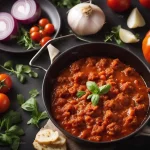Bolognese sauce is a classic Italian dish that has become popular all over the world. It is a meat-based sauce that is traditionally served with tagliatelle pasta, but can also be paired with other types of pasta or used as a topping for pizza. Bolognese sauce originated in the city of Bologna in northern Italy, and has been a part of Italian cuisine for centuries.
The key ingredients in Bolognese sauce are ground beef, tomatoes, onions, carrots, celery, and red wine. The sauce is typically cooked slowly over a low heat for several hours, which allows the flavors to meld together and the meat to become tender. The resulting sauce is rich and hearty, with a deep, savory flavor that is perfect for cold winter nights. While there are many variations of Bolognese sauce, the traditional recipe is still the most popular and widely used.
History of Bolognese Sauce
Bolognese sauce, also known as ragù alla Bolognese, is a meat-based sauce originating from Bologna, Italy. It is a sauce that has been enjoyed for centuries and has become a staple in Italian cuisine.
The first recorded recipe for Bolognese sauce dates back to the late 18th century. It was created by a chef from Bologna named Alberto Alvisi, who wrote down the recipe in his book La Scienza in Cucina e l’Arte di Mangiar Bene (The Science of Cooking and the Art of Eating Well).
Traditionally, Bolognese sauce is made with ground beef, pancetta, onions, carrots, celery, tomato paste, red wine, and milk. The sauce is slow-cooked for several hours to allow the flavors to meld together and create a rich, savory sauce.
Over time, variations of the recipe have emerged, with some using different meats like pork or veal, and others adding additional ingredients like garlic or herbs. However, the traditional recipe remains the most popular and widely recognized.
Today, Bolognese sauce is enjoyed all over the world and is often served with pasta, such as spaghetti or tagliatelle. It is a classic Italian dish that has stood the test of time and continues to be a favorite among food lovers everywhere.
Ingredients and Variations
Meat Choices
Bolognese sauce is traditionally made with ground beef, but other meats can be used as well. Ground pork, veal, or a combination of meats can add a unique flavor to the sauce. Some recipes even use ground chicken or turkey for a lighter version.
Tomato Base
The tomato base of Bolognese sauce can vary as well. Some recipes call for canned tomatoes, while others use tomato paste or fresh tomatoes. San Marzano tomatoes are a popular choice for their sweet and tangy flavor.
Vegetable Additions
Vegetables such as onions, carrots, and celery are commonly used in Bolognese sauce to add flavor and texture. Some recipes also include mushrooms, bell peppers, or zucchini.
Herbs and Spices
Herbs and spices are essential for bringing out the flavors in Bolognese sauce. Common herbs used include basil, oregano, and thyme. Bay leaves and cinnamon are also popular additions for a unique flavor.
Overall, the ingredients used in Bolognese sauce can vary depending on personal preference and regional traditions. Experiment with different combinations to find the perfect flavor for you.
Preparation Techniques
Cooking Methods
When it comes to making Bolognese Sauce, there are a few different cooking methods to choose from. One popular method is to cook the sauce on the stovetop over low heat for several hours. This allows the flavors to meld together and creates a rich, hearty sauce. Another option is to use a slow cooker or crockpot, which allows you to set it and forget it. This method is great for busy weeknights or when you want to have dinner waiting for you when you get home.
Sauce Consistency
The consistency of your Bolognese Sauce is up to personal preference. Some people prefer a thicker, chunkier sauce, while others like it smoother and more liquid. To achieve a thicker sauce, you can use less liquid or let it cook longer to evaporate some of the liquid. For a smoother sauce, you can blend it in a food processor or use an immersion blender to puree it.
Serving Suggestions
Bolognese Sauce is a versatile sauce that can be used in a variety of dishes. It pairs well with pasta, but can also be used as a topping for pizza or as a filling for lasagna. When serving Bolognese Sauce, it’s important to choose the right type of pasta. Spaghetti, fettuccine, and rigatoni are all great options. Top with freshly grated Parmesan cheese and serve with a side salad for a complete meal.
Cultural Significance
Bolognese sauce, also known as ragù alla bolognese, is a meat-based sauce that originated in Bologna, Italy. The sauce is traditionally made with a combination of ground beef and pork, tomato sauce, and a variety of vegetables and herbs.
Regional Differences
While Bolognese sauce is a staple in Italian cuisine, there are regional differences in the way it is prepared. In the city of Bologna, the sauce is typically made with a higher ratio of meat to tomato sauce, resulting in a thicker and more meaty flavor. In other parts of Italy, the sauce may include additional ingredients such as mushrooms, red wine, or cream.
Global Influence
Bolognese sauce has become a popular dish around the world, with many variations of the recipe being created to suit different tastes and cultural preferences. In the United States, for example, Bolognese sauce is often made with ground beef and served over spaghetti, while in the United Kingdom, it is commonly served with tagliatelle pasta.
Despite its global popularity, Bolognese sauce remains a symbol of Italian cuisine and culture. Its rich flavor and versatility have made it a beloved dish that is enjoyed by people of all ages and backgrounds.
Frequently Asked Questions
What are the essential ingredients for a traditional Bolognese sauce?
To make a traditional Bolognese sauce, you will need ground beef, pancetta, onion, celery, carrot, tomato paste, canned tomatoes, red wine, beef broth, and milk. Herbs such as bay leaves, thyme, and parsley are also commonly used.
How do you make an easy Bolognese sauce for beginners?
For beginners, a simple Bolognese sauce can be made by sautéing ground beef with onion, garlic, and tomato paste. Add canned tomatoes, beef broth, and a pinch of sugar, and let it simmer for about an hour. Season with salt and pepper to taste.
What distinguishes a Bolognese sauce from a regular spaghetti sauce?
A Bolognese sauce is a meat-based sauce that is typically made with ground beef, pancetta, and vegetables. It is slow-cooked for several hours, resulting in a rich and savory flavor. A regular spaghetti sauce, on the other hand, may be a simple tomato sauce with herbs and spices.
Can you explain the difference between Bolognese sauce and marinara sauce?
Bolognese sauce is a meat-based sauce that is slow-cooked with vegetables, while marinara sauce is a simple tomato sauce that is typically made with tomatoes, garlic, and herbs. Bolognese sauce is thicker and heartier, while marinara sauce is lighter and more acidic.
What are the steps to creating a Bolognese sauce with a Michelin star quality?
To create a Bolognese sauce with a Michelin star quality, it is important to use high-quality ingredients and take your time with each step. Start by browning the meat and vegetables separately, then combine them and add tomato paste, canned tomatoes, and red wine. Let it simmer for several hours, stirring occasionally. Finish with a splash of cream and grated Parmesan cheese.
What is the secret to achieving an authentic Italian Bolognese flavor?
The secret to achieving an authentic Italian Bolognese flavor is to use high-quality ingredients and take your time with each step. Use a mixture of ground beef and pancetta, and slowly cook the sauce for several hours to develop a rich and savory flavor. Don’t forget to add a splash of milk or cream at the end for a creamy finish.
Print
Bolognese Sauce
- Total Time: 45 minute
Description
Bolognese Sauce is a rich, slow-cooked meat sauce that originates from Bologna, Italy. It’s a cornerstone of Italian cuisine, known for its depth of flavor, which is developed by simmering ground meat (traditionally beef, or a mix of beef and pork) with tomato, onion, celery, carrot, wine, and milk. It’s most commonly served with pasta, particularly tagliatelle, and is a fundamental component of lasagna..
Ingredients
Instructions
Notes
- For an authentic flavor, simmer the sauce for as long as possible, ideally 3-4 hours.
- This sauce freezes well, so you can make a large batch and store it in portions for future use.
- Traditional Bolognese does not use garlic or basil, but these ingredients have been included for added flavor.
- Prep Time: 15 minutes
- Cook Time: 2.5 hours
- Category: Sauce
- Method: Simmering
- Cuisine: Italian
Nutrition
- Calories: 350 kcal
- Sugar: 6 g
- Sodium: 300 mg
- Fat: 22 g
- Carbohydrates: 12 g
- Fiber: 2 g
- Protein: 20 g






